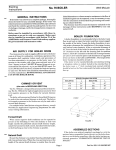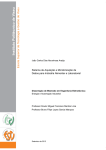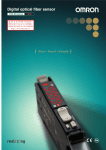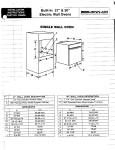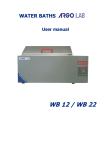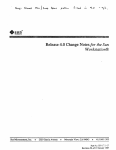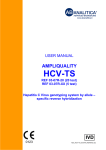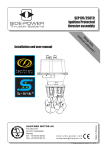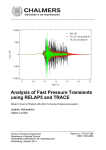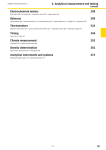Download VB-7313 Series 1/2" to 2" Screwed NPT Three
Transcript
lnvensys Building Systems 1354 Clifford Avenue (Zip 61111) P.O. Box 2940 Loves Park, IL 61132-2940 United States of America VB-7313 Series l/2” to 2” Screwed NPT Three- Way Mixing Valves General Instructions Application VB-7313 series three-way mixing valves control hot or chilled water in heating or air conditioning systems. These valves must be piped with two inlets (“A” and %” ports) and one outlet (“AB” port). They are used for twoposition or proportional control applications. Valve assemblies require an actuator and avalve linkage that must be purchased separately. n ! Danger: Do not use for combustible gas applications. The VB-7313 series valve packings are not rated for combustible gas applications, and if used in these applications, gas leaks and explosions could result. Features Valve sizes l/2” to 2” 250 psig pressure rating per ANSI Standards (B16.15-1985) for screwed cast bronze bodies Spring-loaded TFE packing American Standard Taper Pipe Thread (NPT) connections Applicable Literature Siebe Environmental Controls Catalog, F-25683 Siebe Environmental Guide, F-23638 Controls Cross-Reference Siebe Environmental F-21 683 Controls Siebe Environmental F-2 1335 Controls Application Reference Manual, Manual, Control Valve Sizing, F-l 3755 Valve Selection Chart for Water, F-l 1080 EN-205 Water System Guidelines, Printed in U.S.A. 9-97 F-26080 F-26074 SPECIFICATIONS Table-l Specifications/Models. Valve Body Series VB-7313-O-4-P Specifications Service Chilled Flow Characteristics (Figure-l) Mixing I 112” Sizes Type of End Fitting to 2” NPT Valve Materials Body Bronze Seat Bronze Stem Stainless Plug Brass Packing Spring-loaded TFE Disc Steel None 1250 (up to 400 psig below 150”F)a ANSI Pressure Class (Figure-2) 1Allowable or Hot Water 120to 281 “F (-7 to 138°C) Control MediaTemperature I 35 psi (241 kPa) Max. for Normal Allowable Differential Valve Size Life (refer to “Cavitation Limitations on Valve Pressure Drop” on page 6) Pressure for Waterb kvs RatingC Complete Valve Body Part Number 2.2 1.9 VB-7313-O-4-2 4.4 3.8 C, Rating l/2” 314” 1 IN 1 -l/4” l-1/2” I 7.5 I I I 20 2” I I I I 14 28 6.5 41 12 17 24 VB-7313-o-4-4 I I I I VB-7313-o-4-6 VB-7313-o-4-a VB-7313-o-4-9 VB-7313-o-4-10 35 VB-7313-O-4-11 Do not apply above pressure rating to piping system. b Maximum recommended differential pressure. Do not exceed recommended differential pressure (pressure drop) or integrity of parts may be affected. Exceeding maximum recommended differential pressure voids product warranty. c b,s = m3/h (AP = 100 kPa) C,=b,,x1.156 Close-off Pressure The close-off pressure actuator. ratings. 2 Rating rating is dependent Consult the Siebe Environmental on the size of the valve, valve linkage, Controls Catalog, F-25663, and for close-off Spring Return Position of Valve Assembly For a valve assembly (valve, linkage, and actuator) to have a spring return position, the actuator must be of the spring return type. See Table-2 for spring return position of valve assemblies. Table-2 Required Compatible Actuators/Linkages. 1Required Valve Linkage 1 Spring Return Positiona Actuator Series MA-316, MA-416, MA-479 I AV-397 MC-351, MC-437, MC-437 1, MC5-437 1 I 1 AV-7600b AV-393 I I MF-547 3, MF-557 3 1 AV-7600 & AV-601 1 MA-527 0, MA-521 7, MA-5213 MF-22203, MF-22303, MF-63703, MF-63123 1 None I Up MK-4601, MK-4611, MK-4627 MK-6601, MK-6627 AV-430 MM-400, MMR-400 None I AV-7400 AV-407 Stem Up AV-630 or AV-630-10 MM-500, MMR-500 MP-367, MP-467-600, MP-465, MP5-4651 AV-397 I MP-477-600, MP-475, MP5-4751 M P-367 I MP-362, M P-461 -600, M P-465, M P-466, MP-4851, M P5-4657 MP-5270, Stem MF-22323 MK-2690 MP-377 Up or Down Stem Up Included w/Actuator MK-6617, Stem MP-5217, MP-5213 MP-5470, MP-5411, MP-5413 AV-393 None AV-7600b Stem Up AV-7600 & Ail-601 M P-557 3 MPR-5670, MPR-5671, MPR-5613 AV-7600 & AV-601 Stem Up M PR-577 3 I MS-22353 Included w/Actuator I None Stem Up = Flow port “B” to port “AB”. Stem Down = Flow port “A” to port “AB? b High ambient temperatures with high media temperatures in the valve may require the use of AV-601 in addition to AV-7600. See General Instructions for AV-7600 (F-26235) and AV-601 (F-l 9069) for details. Flow Characteristics Three-way mixing valves are designed so that the flow from either of the inlet ports to the outlet is approximately linear, which means the total flow from the outlet is almost constant over the stroke of the valve stem. See Figure-l for typical flow characteristics of VB-7313 series valve bodies. s :: g Stem In Figure-l 8 s Stroke s $ s z Stem Out 8 8 - Typical Flow Characteristics. 3 Rangeability Rangeability is the ratio of rated flow to the minimum controllable flow through a valve. For mixing valves, control begins as soon as plug displacement allows flow. Thus, three-way valve rangeability normally exceeds 500:1, which is the reciprocal of 0.2% nominal leakage. Temperature/Pressure Ratings See Figure-2 for temperature and pressure ratings. Consult the appropriate valve linkage general instruction sheet for the effect of valve body ambient temperatures on specific actuators. Ratings conform with published values and disclaimer. VB-7313-O-4-P (Screwed Cast Bronze Body) Standards: Pressure to ANSI B16.15 Class 250 with 400 psig up to 150°F decreasing 321 psig at 281°F Materials: Bronze, ASTM B584 321 psig (2218 kPa) Maximum Fluid f 150 (65) % cl E 100 (38) Minimum Fluid I-” 50 (10) I I I 250I 350I 150 2oo (1724) 3oo (2458) 4oo 1 o. (1034) (689) (1379) Pressure-psig (2068) (2758) (kPa) Figure-2 Temperature and Pressure Ratings for VB-7313 Series Valve Bodies. to VALVE SIZING AND SELECTION Water Two-position Two-position control valves are normally selected “line size” to keep pressure drop at a minimum. If it is desirable to reduce the valve below line size, then 10% of “available pressure” (that is, the pump pressure differential available between supply and return mains with design flow at the valve location) is normally used to select the valve. Proportional to Bypass Flow Proportional valves used to bypass flow (Figure-5) are piped on the outlet side of the load to throttle the water flow through the load and therefore control heat output of the load. These valves are usually selected to take a pressure drop equal to at least 50% of the “available pressure.” As “available pressure” is often difficult to calculate, the normal procedure is to select the valve using a pressure drop at least equal to the drop in the coil or other load being controlled (except where small booster pumps are used) with a minimum recommended pressure drop of 5 psi (34 kPa). When the design temperature drop is less than 60°F (33°C) for conventional heating systems, higher pressure drops across the valve are needed for good results (Table-3). Table-3 Conventional Heating System. Multiplier on Load Drop Design Temperature Load Drop “F (“C) Recommended Pressure Dropa (% of Available Pressure) 60 (33) or More 50% 1 x Load Drop 40 (22) 66% I 2 x Load Drop 1 20 (11) 75% I 3 x Load Drop 1 Recommendedminimum pressure drop = 5 psi (34 kPa). Secondary Circuits with Small Booster Pumps: 50% of available (equal to the drop through load, or 50% of booster pump head). Proportional to Blend Water pressure difference Flows Proportional valves used to blend two water flows (Figure-6 and Figure-7) control the heat output by varying the water temperature to the load at constant flow. These valves do not require high pressure drops for good control results. They can be sized for a pressure drop of 20% of the “available pressure” or equal to 25% of the pressure drop through the load at full flow. Water Capacity See Table-4 for water capacity of VB-7313 series valves. ‘able-4 Water Capacity in Gallons Per Minute for VB-7313 Series. VB-7313-o-4-10 28 28 39 48 56 63 69 74 79 84 88 108 125 166 VB-7313-o-4-11 41 41 58 71 82 92 100 109 116 123 130 159 183 243 C, Equation c = v GPM w AP = (F)’ GPM = C,m V Where: = Coefficient of flow cv GPM = U.S. gallons per minute (6O”F, 15.6”C) AP = Differential pressure in psi (pressure drop) Cavitation Limitations on Valve Pressure Drop A valve selected with too high a pressure drop can cause erosion of discs and/or wire drawing of the seat. In addition, cavitation can cause noise, damage to the valve trim (and possibly the body), and choke the flow through the valve. Do not exceed the maximum differential pressure (pressure drop) for the valve selected. The following formula can be used on higher temperature water systems, where cavitation could be a problem, to estimate the maximum allowable pressure drop across the valve: Pm = 0.5 (PI - Pv) Where: Pm = Maximum allowable pressure drop (psi) P, = Absolute inlet pressure (psia) Pv = Absolute vapor pressure (psia) (refer to Table-5) Note: Add 14.7 psi to gauge supply pressure to obtain absolute pressure value. For example, if a valve is controlling 200°F water at an inlet pressure of 18 psig, the maximum pressure drop allowable would be: Pm = 0.5 [(18 + 14.7) - 11.531 = 10.6 psi (Vapor pressure of 200°F water is 11.53 psia.) If the pressure drop for this valve is less than 10.6 psi, cavitation should not be a problem. Systems where cavitation is shown to be a problem can sometimes be redesigned to provide lower inlet velocities. Valves having harder seat materials should be furnished if inlet velocities cannot be lowered. Table-5 Water Temp. (“Fj Vapor Pressure of Water Table. Vapor Pressure 1 (psia) 40 Additional Valve Sizing Information I 1 Water Temp. (“Fj Vapor Pressure 1 (psia) I 1 Water Temp. (“Fj Vapor Pressure 1 (psia) I Water Temp. 1 (“Fj Vapor Pressure 1 (psia) 0.12 90 0.70 140 2.89 190 9.34 100 0.95 150 3.72 200 11.53 50 0.18 60 0.26 110 1.28 160 4.74 210 14.12 70 0.36 120 1.69 170 5.99 220 17.19 80 0.51 130 2.22 180 7.51 230 20.78 For additional valve sizing information, see: l CA-28 Control Valve Sizing, F-l 3755 l Valve Selection Chart Water, F-l 1080 l Valve Sizing Slide Rule, TOOL-150 INSTALLATION Inspection Inspect the package for damage. If damaged, notify the appropriate carrier immediately. If undamaged, open the package and inspect the device for obvious damage. Return damaged products. Requirements l Tools (not provided): l Training: Installer must be a qualified, experienced l Appropriate Pipe wrenches technician accessories Caution: Mounting l Install the valve with the flow in the direction of the flow arrows (“A” and “B” ports are inlets and “AB” port is the outlet). l Do not exceed the ratings of the device. l Avoid locations where excessive moisture, corrosive fumes, or vibration are present. The valve should be mounted in a weather-protected area in a location that is within the ambient limits of the actuator. When selecting a location, allow sufficient room for valve linkage, actuator, and other accessories and for service of the product. The preferred mounting position for the valve is with the valve stem vertical above the valve body. Avoid mounting the valve so that the valve stem is below horizontal. The valves must be piped with two inlets (“A” and “B” ports) and one outlet (“AB” port). Screwed Valve Bodies The VB-7313-O-4-P Threads (NPT). series screwed valve bodies conform to American Standard Taper Pipe Apply pipe dope sparingly to all but the last two threads of a properly threaded, reamed, and cleaned pipe. Make sure that pipe chips, scale, etc. do not get into the pipe since this material may lodge in the valve seat and prevent proper closing and opening of the valve. Start the joint by hand screwing the pipe into the valve. If the thread engagement “right,” turn the pipe by hand as far as it will go. feels Use a pipe wrench to fully tighten the valve to the pipe. Do not over tighten or strip threads. SeeTableand Figure-3 for the normal engagement length of the threads. Figure-4 shows a means of tightening the pipe so that the valve is not twisted or crushed. Table-6 Normal Thread Engagement Valve Size Inches (NW 314" 1 I8 Valve Size Inches (NW Normal Engagement 112" I Between Male Pipe Thread and Valve Body. 9/16" 11116" lll16" l-1/4" 112" I Normal Engagement I I l-112" 2" I lll16" 314" Pipe threads too long. Pipe interferes with seat. Figure-3 Normal Thread Engagement. Tighten pipe using this pipe wrench. --vi / ’ L Figure-4 8 Installation of Screwed Use pipe wrench to prevent valve from turning. End Valves. TYPICAL PIPING All piping Figure-7 must comply for typical with local codes and ordinances. Refer to Figure-5 through piping. Stem down flow through coil. Stem up flow through coil bypass. Figure-5 Typical Piping Stem up flow through coil. Stem down flow through coil bypass. for Control Valve Bypass of Heating or Cooling System Pump I I Return Figure-6 Typical + Balancing Cock ( 1 Boiler Coil Hot Water I_ Reset. 1 rl J From Other Zones To Other Zones 3 Balancing Cock Return Figure-7 Typical Primary-Secondary 1 SUPPlY Piping. Coil. CHECKOUT 1. Make sure the valve stem operates smoothly before installing the valve linkage and the actuator. 2. If the stem does not operate smoothly, it may indicate that the valve was twisted or crushed during installation or that the stem was bent by rough handling. These conditions may require that the valve be replaced. 3. After the piping is under pressure, check the valve body and the connections for leaks. 4. After the valve linkage and the actuator are installed, check their operation. a. Drive the actuator and run the valve to the stem down position. Make sure the linkage and valve stem move freely. At the stem down position, the valve should shut off the “B” port. b. Drive the actuator and valve to the stem up position. Again, the valve stem and linkage should operate smoothly. At the stem up position, the valve should shut off the “A” port. MAINTENANCE Regular maintenance of the total system is recommended See Table-7 for maintenance kit part numbers. Table-7 Maintenance Kits for VB-7313 Valves. Valve Body Part Number Replacement Packing Assembly Water System Maintenance Packing Wrench Valve Repair Kita VB-7313-O-4-2 RYB-731-2 VB-7313-O-4-4 RYB-731-4 VB-7313-O-4-6 RYB-731-6 VB-7313-O-4-6 a to assure sustained petformance. TOOL-20-1 YBA-622-1 RYB-731-8 VB-7313-O-4-9 RYB-731-9 VB-7313-o-4-10 RYB-731-10 VB-7313-o-4-11 RYB-731-11 Kit includes replacement packing and stem & plug assembly. All heating and cooling systems are susceptible to valve and system problems caused by improper water treatment and system storage procedures. These guidelines are provided to help avoid valve and water system problems resulting from improperly treated water or storage procedures in cooling and hot water systems, and to obtain maximum life from Siebe Environmental Controls valves. Durability of valve stems and packings is dependent on maintaining non-damaging water conditions. Inadequate water treatment or filtration, not in accordance with chemical supplier/ASHRAE handbook recommendations, can result in corrosion, scale, and abrasive particle formation. Scale and particulates can result in stem and packing scratches and can adversely affect packing life and other parts of the hydronic system. To maintain non-damaging conditions, follow these guidelines: Clean the system prior to start up. Use a nitrite or molybdate-based Use filtration equipment Properly store off-line systems and monitor water treatment coupons. Follow the advice of a water treatment program. results using corrosion test professional. Consult EN-205, Water System Guidelines further details. 10 treatment where needed. Engineering Information, F-26060,for DIMENSIONAL DATA Table-8 Dimensions for VB-7313 Series Valves (Figure-8). VB-7313-0-4-2 VB-7313-0-4-4 l/2" 3-l/16 (78) l-318(35) VB-7313-0-4-6 314" 3-5/8(92) l-11/16(43) VB-7313-O-4-6 1IN VB-7313-0-4-9 l-114" VB-7313-0-4-10 l-1/2" VB-7313-0-4-11 2" l-11/16(43) l-9/16(40) l-314(45) l-5/8(41) 2(51) 5-3/8(137) l-9/16(40) l-118(29) 6-l/8(156) l-718(48) l-3116(30) 4-5/8 (118) Figure-8 Typical of VB-7313-0-4-P 314 (19) 7/16 (11) Valve Bodies. 11 F-26074 BK Specifications may change as design improvements are introduced. Printed in U.S.A.












